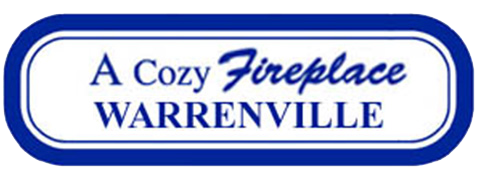FAQs
A Cozy Fireplace Warrenville
Have a fireplace-related question? We have the answer. Check out these FAQs and give us a call today for more information!
Can I convert my wood-burning fireplace to a gas fireplace?
Yes. We have gas inserts designed for both masonry and factory-built wood-burning fireplaces.
How do I know if I need an insert or a fireplace?
If you want to convert your brick or stone fireplace to gas, then the most cost effective solution would be an insert. If you are remodeling a part of your home that never had any kind of built-in structure, then you need a direct vent fireplace that does not require an existing opening or chimney.
What is the difference between a B Vent and Direct Vent fireplace/insert?
These terms refer to how a gas appliance takes in the air it needs to burn gas. A B Vent unit draws air from inside the home, through ports in the firebox itself. A Direct Vent unit draws air through a pipe from outside the home into a sealed firebox. Direct Vent models are more efficient and safer for today’s airtight homes since they do not use inside air to cause a conflict with range hoods and bathroom fans circulating the same air. B Vent units are generally less expensive to install, but are more sensitive to airflow inside the home.
What is a BTU?
A BTU refers to the heating power of a gas appliance as measured by the amount of energy it produces within an hour. On average, a 10,000 BTU component can heat up approximately 500 square feet, depending on floor plan.
Can I burn wood in my gas fireplace or stove?
No. Gas models are specifically designed to burn gas.
I don’t want to see too much stove pipe inside my home. What options do I have?
You could install a rear vent stove, which vents directly out of the back of the stove. If you are unable to vent out the rear of the unit you can minimize the amount of visible pipe with a 2′ or 4′ snorkel cap horizontal termination kit for direct vent stoves.
What is the difference between “steady state” efficiency and AFUE?
Steady state efficiency means only the efficiency of the fireplace when its burning is tested. AFUE, or Annual Fuel Utilization Efficiency, means that the on and off cycle are calculated by the rating. A more accurate yearly cost is estimated if the off cycle is included.
How often should I have my fireplace serviced?
Your fireplace should be inspected annually by a technician.
Should I leave my pilot light on in the summer when I am not using it?
Running the pilot light year-round will extend the lifespan of the generator by not allowing condensation and corrosion to build up.
How do I re-light my pilot?
Open the lower grill and locate the black on/off pilot knob. Turn the knob to the pilot position, push in the black knob all the way and hold it in. Then, press the red button that is to the right-hand side; the pilot will light after you push this button on two times. Continue to hold the black knob in for at least 20 seconds after the pilot has been lighted. Release the black knob and the pilot will remain lit. Turn the black knob all the way counter-clockwise to the on position.
FAQ - Pellet Burning Stoves
Where should I position my pellet stove?
Your family room, living room, or wherever your family spends a lot of time is generally a good idea. Your stove should be near a properly wired outlet and must adhere to proper venting requirements.
What are my choices for floor protection?
The floor must be protected according to manufacturer instruction. Choices of suitable materials typically require professional assistance, unless a suitanle hearth is available.
What are the routine maintenance tasks I need to perform to keep the stove working properly?
Daily checks, emptying the ash drawer, cleaning the glass and heat exchanger, and checking the hopper regularly are routine checks you could be doing.
What professional maintenance and repair services will I need?
We will take care of a handful of services for you. We will empty ash traps, clean fans and motors, clean the hopper, clean the heat exchanger system, clean exhaust pipes, verify and adjust the stove settings, and repair and replace components if needed.
FAQ - Wood Burning Fireplaces
What does "EPA certified" mean?
An EPA certified appliance complies with strict emissions and efficiency regulations designed to reduce pollution and control energy costs. The EPA certification is your guarantee that the stove you are buying will burn cleanly and efficiently, reducing your heating costs and protecting the air we breathe.
What is the difference between catalytic converters and secondary combustion?
A catalytic converter is a device through which wood smoke is channeled. It lowers the combustion temperature of the gases, allowing them to be consumed at lower firing. Secondary combustion mixes air with the exhaust gases, causing them to reignite and burn before going up the chimney.
Will the glass door of my fireplace/insert stay clean?
Most models are designed so air is forced in front of the glass to keep flames and exhaust away. This will keep your door clean longer, however you may need to do some cleaning after a period of time.
Do I need a blower?
A blower is a good way to spread the heat around your house quickly but it does not affect the combustion rate of fire. We would recommend a blower if you are trying to heat a large room or several rooms.
Can I convert my wood stove to gas?
No. Wood stoves are meant to only burn wood.

Share On: